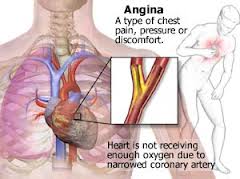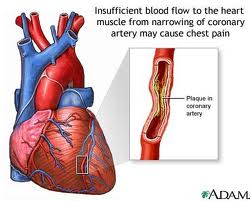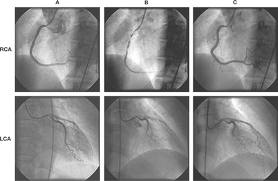What is Angina Pectoris?
Table of Contents
The term Angina Pectoris is the medical term for chest pain that involves the heart and surrounding structures. This type of chest pain is cardiac (heart) in nature and a signal that there may be a cardiac (heart) problem. (See Figure 1)
Figure 1: Angina Pectoris
Courtesy of HeartOnline.org
Angina is a sign that the heart muscle is not getting enough blood and oxygen. This is seen in people with heart disease, blocked arteries and veins and people with chronic disease that damage the blood vessels. It is a pain that should never be ignored and physicians can rule out of the pain is truly cardiac related or if there is another cause. Some other reasons for chest pain are; heartburn/reflux, lung disease and pulled muscles in the chest.
There are two types of Angina; Stable Angina and Un-stable Angina. The differences are outlined below:
- Stable Angina – This type occurs with stress, physical activity or hard work. It is relieved by rest or medication.
- Un-stable Angina – This type occurs with activity and at rest. It is not easily relieved by rest and medication. Could be a sign of an impending heart attack.
This condition is most common in middle aged men, women and children that have congenital heart disease. It is important to understand that women tend to experience angina differently than men and should understand the differences noted in the symptoms section below.
What are the Causes of Angina Pectoris?
The heart needs blood filled with oxygen, nutrients and electrolytes to function properly. If any of these are diminished or completely cut-off the heart muscle sends out a pain signal to let you know something is wrong. Angina Pectoris does not necessarily mean a “heart attack,” but it does signal that the blood vessels are beginning to narrow. (See Figure 2)
Figure 2: Blockage in the Arteries to the Heart
Courtesy of Health Central.com
The heart is surrounded by tiny blood vessels called “capillaries,” these feed the actual heart muscle. They are usually the first to become clogged with plaque due to high cholesterol and/or high blood sugar. Then factor in; aging, hardening of the arteries, smoking (causes constriction) and poor health habits, which all cause the heart to lose oxygen.
People will most often notice angina when they are doing activities that increase the heart rate and make it work harder. These include; exercise, walking, climbing stairs, sexual intercourse, Periods of high stress and heavy housework. This is because the harder the heart has to work, the more oxygen it needs. This cannot happen if the blood vessels are narrowed.
Symptoms of Angina
The classic symptom of angina is chest pain. There are other associated symptoms that need attention and evaluation by a doctor along with the chest pain. These include:
- Feeling of impending doom or anxiety attacks
- Shortness of Breath
- Dizziness
- Profuse Sweating
- Nausea and/or Vomiting with abdominal pain (May be the only symptom in women)
- Weakness/Fatigue
Some of the telltale signs that a person is experiencing angina pectoris are a squeezing feeling in the chest along with pain that radiates up the jaw bone or down an arm. The first time a person experiences any of these signs and symptoms, they should seek emergency medical attention right away for evaluation. If the symptoms are cardiac in nature, the doctor will give instructions or medications to help alleviate the symptoms. The doctor will also explain what to do if the symptoms persist or get worse.
What is the treatment for Angina Pectoris?
The treatments for angina fit into a few different categories. People with unstable angina are usually referred for a procedure that opens the blood vessels back up. This is called coronary stenting. If angina is stable, medications along with lifestyle changes can help to control the condition. Let’s take a look at the different categories for treatment:
Medications used for Angina
- Nitroglycerin – This medication is a nitrate that quickly opens up blood vessels and allows needed blood to flow into the heart.
- Aspirin – Aspirin thins the blood and prevents clotting. It helps with blood flow and helps to prevent heart attacks.
- Blood-Pressure Medications – Calcium channel blockers, beta-blockers and ACE inhibitors all help to relax the vessels lowering blood pressure and increasing blood flow to needed areas.
- Statins – These are medications that lower cholesterol and prevent blood vessels from being clogged.
Procedures used for Angina
- Stent Placement – This procedure is done on an outpatient basis. The patient is admitted to the hospital for the day and taken to a cardiac catheterization lab. Once prepped, the doctor inserts a catheter into the groin artery. Dye is injected into the arteries to find any areas that are narrowed or blocked. A balloon is placed through the catheter into any areas of blockage and then inflated. This is known as angioplasty. Problem areas get a wire stent placed to continue to hold the blood vessel open after the balloon is deflated. (See Figure 3)
Figure 3: Picture of Angioplasty
Courtesy of Nature.com
- CABG (Coronary Artery Bypass Grafting) – For cases of severe blockage and chronic unstable angina, the patient may be referred to a cardiac surgeon for bypass grafting. This procedure is open heart surgery where one or more blood vessels are replaced by grafting from somewhere else in the body.
Lifestyle Modifications
- Dietary Changes
- Exercise
- Quitting Smoking
- Quitting Alcohol Use
- Weight Loss if needed
- Stress Management
- Treat Diabetes, High Cholesterol, High Blood Pressure
- Support Groups
Conclusion
Patients with chest pain can live normal healthy lives with certain modifications. Angina Pectoris is a condition that can be managed with medications and lifestyle changes. It is important to seek medical treatment right away if the symptoms are severe. Chest pain is not always cardiac (heart) related, but only a physician can properly diagnose the symptoms.



